The Money Tree Care at Home
Crassula is a fairly common indoor plant, which is better known to all of us as the “money tree”. This species gained its popularity not only due to the magical abilities to bring good luck and wealth to the owner, but also due to its undemanding nature and endurance. You can order a money tree, as well as other flowers in Kyiv online, without leaving your home or office.
Caring for the Money Tree
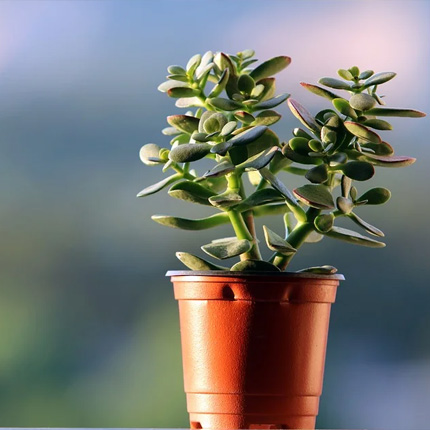
The scientific name of the money tree is Crassula arborescens. In its natural environment, the plant grows in the dry regions of South Africa, Madagascar, and also on the Arabian Peninsula. But for many years already, this succulent can be found on the windowsills in our apartments. Crassula is a branched and rather compact tree or shrub with fleshy round or oval leaves of deep green color. It lends itself well to pruning and decorative crown formation. Flowering in the species, with small white inflorescences, is very rare and can be observed not earlier than at 6-10 years of age, on condition of competent and responsible care. However, caring for crassula is no more difficult than caring for a coffee tree, so you don’t need any special skills.
Location
The money tree is so unpretentious that it can take root both in a warm and cool environment. At the same time, it feels great in the shade, so there should not be any special problems with choosing the right spot. The only condition is to avoid surfaces that are next to heaters and radiators. The south and southeast side of the apartment is ideal for crassula.
Access to oxygen will never be superfluous for the plant. House owners are advised to take the pot out into the yard, onto the terrace, or to the gazebo in the warm season. In case of an apartment, simply try to arrange more frequent ventilation sessions or put the flower on the balcony.
Planting
Crassula soil mixtures can be found at any specialized gardening store (even a cactus substrate will do), but you can also prepare the soil yourself. If you choose the second option, you will need expanded clay, river sand, leafy humus, and lowland peat in a ratio of 3:2:2:2. Expanded clay balls act as drainage; place them at the bottom of the container, mix all the remaining components well, and put them into the pot. If you notice hard lumps in the soil, they must be carefully rubbed away. Otherwise, they will prevent the free access of moisture and nutrients to the roots.
Now you can start planting the crassula. It doesn’t require transplanting, as the pot must be changed to a new one only when it becomes too small.
Lighting
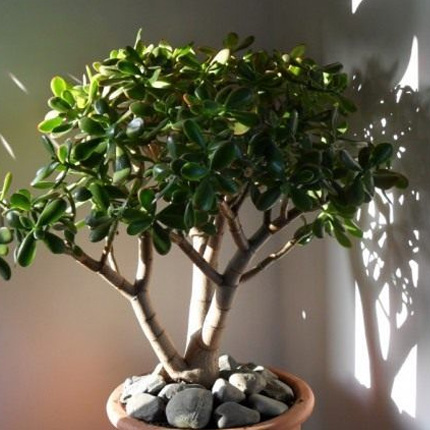
Almost all representatives of the Crassulaceae family are generously endowed with the sunrays and are deprived of regular rains in natural conditions. You can safely put crassula on the sunniest windowsill of your house. However, constant direct exposure to sunlight should still be avoided so that the leaves don’t get burned.
Temperature and Humidity
This talisman of wealth will delight you all year round with its green color at room temperature – and will not wither if it suddenly gets warmer or colder. The temperatures of 20-28°С (68-82.4°F) in spring and summer, and 10-15°С (50-59°F) in autumn and winter, are considered the best for the stable growth and development of crassula. Since the plant has dormant periods during the cold season, try not to allow the temperatures to rise so that crassula doesn’t lose its leaves ahead of time. When the heating systems start to work at full capacity, don’t forget to ventilate the room more often, but avoid drafts at the same time. The excessive lowering of temperature will also not benefit the plant, so you shouldn’t allow it to be less than 3°C (37.4°F) indoors. However, not a single flower could live normally in such a microclimate. Crassula doesn’t like high humidity, so the spray gun can be put aside. To make the flower look neat, it is enough simply to wipe off the dust from time to time, which is quite clearly visible on the thickened glossy leaves.
Watering
You need to water the plant regularly, but prevent soil waterlogging. The money tree will simply begin to rot with excessive moisture. In addition, the highly moist soil is an ideal breeding ground for fungal infections. It is not difficult to notice when the crassula root system begins to rot: the leaves of the flower become yellow, drooping, and lethargic. It is also very important to cut the crassula in a timely manner so that the indoor plant doesn’t break under the weight of its branches and cuttings.
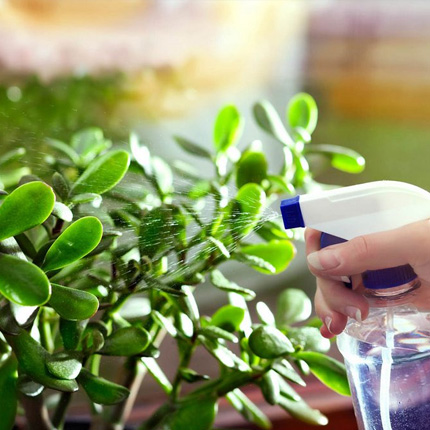
In warm spring and summer, the money tree should be watered no more than twice a week after checking the levels of soil moisture. The top layer 3-4 cm (~0.1 ft.) thick should be dry. You can use a special tool for checking the moisture level of the substrate. However, the easiest way to do this is with an ordinary wooden stick. Carefully immerse it in the ground for about 5 cm (0.2 ft.). If it is damp or clods of soil stick to it, then it is too early to water crassula. In late autumn and winter, the watering schedule for the plant should be cut in half.
Top Dressing
Every indoor plant needs fertilizers, and the money tree is no exception. You can use any special preparations for top dressing that are intended for cacti and other succulents. In the warm period, it is necessary to feed crassula once every two weeks, and in the cold season, once a month. However, keep in mind that it is better to mix the fertilizer with purified (or at least settled) water in a ratio of 1:2, since crassula doesn’t need concentrates. It is recommended to apply the fertilizer immediately after watering.
Transplanting
As mentioned above, it is often not necessary to transplant the money tree. When the root system grows to such an extent that the transplanting becomes inevitable, all that is required of you is to get a new pot, which should be wide, but shallow. The following actions will be exactly the same as with planting: a drainage layer of expanded clay is laid on the bottom, and a soil mixture is placed on top. You can add a little wood ash if you wish. What’s more, the expanded clay can be replaced with river pebbles. Don’t forget to water the plant immediately after transplanting and put it in its usual spot.
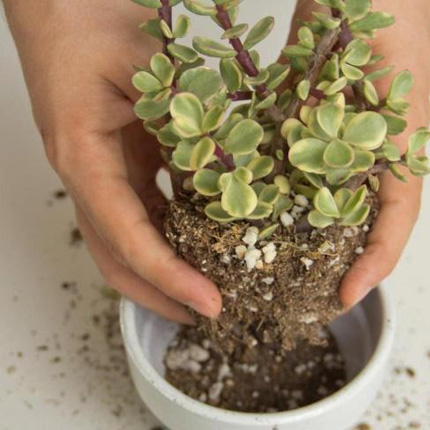
If you want the crown of the plant to be evenly lush and branched, periodically turn the pot to the sun with different sides. In this case, the money tree will grow really slender, and the fleshy leaves will be perfectly shaped. A tall mature plant can lean to one side under the weight of its crown. To avoid this, tie the crassula trunk to a long piece of wood.
Crassula Propagation
The plant can be propagated in three ways: by dividing the shrub, cuttings, and seeds.
Propagation by Seeds
This method is the least often used one, since it is very long and painstaking. In general, breeders resort to it for growing new hybrids. The main peculiarity of this method is that the young seedlings may have nothing to do with the mother plant at all. A mixture of leafy soil and river sand in a ratio of 2:1 is suitable for sowing. Spread the seeds evenly on the surface and lightly sprinkle with sand. Next, water well and cover the pot with a transparent film. From time to time, give the seedlings some fresh air and check the soil for moisture levels. If all the requirements are met, the first shoots will appear in the third week. When this happens, the protective film can be removed and the container placed in a well-lit area. After that, the sprouts 5-6 cm (~0.2 ft.) high can be transplanted into separate pots.
Propagation by Cuttings
Young cuttings should be placed in a glass of water. To make the plant take root faster, you can add a little activated charcoal to the water. While the cuttings can be immediately rooted in the soil, preliminary germination in water will still contribute to the more active growth. As soon as the roots appear, crassula can be planted in a pot. At first, don’t forget to regularly water it (once a day) and keep a stable temperature of about 17-18°C (62.6-64.4°F).
Propagation by Leaf
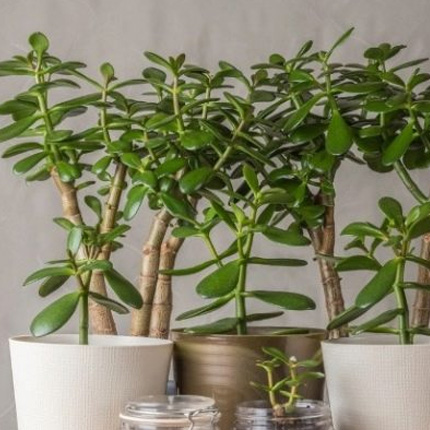
The money tree can be successfully grown even from a leaf, and preferably from a wilted one. If all the leaves on your plant are healthy, you can cut one off and simply put it on the windowsill for a day. Take a leaf and dip it into a glass of water at the cut point to a depth of 0.5 cm (0.2 in.). If desired, you can add a growth stimulant solution to the water. After that, monitor the level of humidity. It is also recommended to build a cellophane shelter for the seedling. When the roots germinate, proceed with planting crassula in the ground.
Possible Diseases and Issues
Unfortunately, any indoor plant is susceptible to diseases and pest infestations. Spider mites, felt, and scale insects are of particular danger to crassula and, in general, to all succulents. Let’s take a closer look at the symptoms that occur in crassula when infected with each of these parasites.
If you notice a thin cobweb on the leaves and shoots of a flower, this is the work of a spider mite. The web is so thin that it doesn’t even immediately catch the eye, so it is recommended to carefully examine crassula with each watering. In the first stages of infection, the plant can be saved with the usual soap solution. In all other cases, systemic insecticides will be required.
You can also get rid of felt with a solution of laundry soap or insecticides. The sign of infection is the appearance of a plaque resembling mold. If you spot a parasite right on a leaf, “reward” it with an alcohol lotion.
When the money tree is infected with a scale insect, yellow and brownish blotches form on its parts. You can get rid of these parasites in exactly the same way as described above.
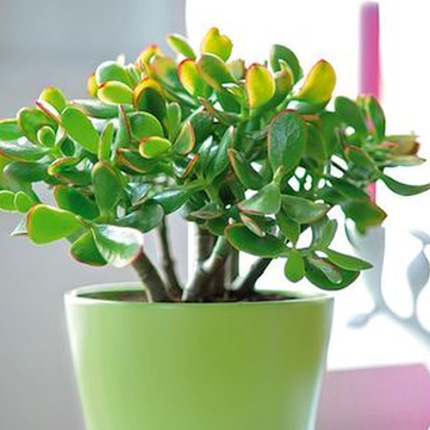
A sick plant may experience root rot. This can happen if watering is too plentiful and frequent, when crassula simply doesn’t absorb the entire volume of consumed moisture. This issue occurs most frequently for novice gardeners. However, if you water crassula once a week, the root rot will not threaten it. Transplanting the flower into a fresh soil mixture will help solve an already existing problem.
Slow growth and development. If you think that the money tree will grow to the level of 30-40 cm (1-1.3 ft.) in the very first months of its life after planting, you are mistaken. However, it is still possible to accelerate crassula’s growth. For this, it is enough to simply organize conditions for the flower that are the closest to natural.
Falling leaves. Anyone can face this problem; the leaves that fall too frequently always signal negative changes. The reasons for this may be drafts, excessive fertilizing, or watering that is too cold.
The Money Tree’s Useful Properties
Crassula has become a favorite of many, and not only due to its attractiveness. The plant has excellent antiviral properties and effectively removes harmful bacteria from the indoor air. Crassula is also a symbol of prosperity. Interestingly, the flower received its name “the money tree” not at all because its round leaves are so reminiscent of coins. The reason is that crassula very quickly absorbs moisture and nutrients from the soil, keeping them inside, as if in a piggy bank.
The leaves of the money tree have a unique property. After they fall off and dry out, they become no less beautiful. The dark green color changes to silver, and the leaf plate still retains its strength and doesn’t crumble into dust. What’s more, when the sunrays fall on the pot with the fallen leaves, it seems as if these are diamond placers.
